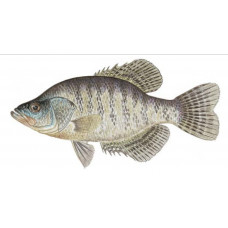Latin name
Pomoxis annularus
Other names
Crappie, speckled perch, speckled bass, calico bass, sacalait, papermouth, bachelor perch; French: crapet calicot.
Identification
White crappie and black crappie are the same colour, ranging from silvery olive to bronze with dark spots, although white crappie is slightly paler. It has spots arranged in seven or eight vertical stripes on the sides, while black crappie has spots scattered. The white crappie is dense and compressed at the sides, with a large mouth, an upper jaw that protrudes below the eye and a lower jaw that appears to protrude forward. It also has distinct indentations on its forehead and large dorsal and anal fins of almost equal size. The best way to tell them apart is to count the spines on the dorsal fin, as the white crappie has six and the black usually has seven or eight. The white crappie is also the only sunfish with the same number of spines on both the dorsal and anal fins. The breeding male becomes darker in colour and is often mistaken for a black crappie.
Distribution
Widespread in North America, the white crappie is found in the Great Lakes, Hudson Bay, Mississippi River basins from New York and Ontario west to Minnesota and South Dakota and south to the Gulf of Mexico. It also inhabits the Gulf of Mexico drainages from Mobile Bay in Georgia and Alabama to the Nueces River in Texas. Has been widely introduced into other countries.
Habitat
White crappie can be found in backwaters of streams, slow flowing streams, pools with sandy and muddy bottoms, small and large rivers, lakes and ponds. They prefer shallower water than black crappie and can tolerate warmer, murky and slightly alkaline water. They are usually found near bluffs, standing timber, brush or other artificial cover. Like white crappie, they gather in loose groups. They are particularly active in the evenings and early mornings and remain active throughout the winter.
Size
White crappie can grow to 5 pounds, but are usually less than 2 pounds and are usually caught at a pound or less. The world all-tackle record is a 5lb 3oz fish caught in Mississippi in 1957. White crappie live up to 10 years.
Life history and Behavior
Spawning takes place in early spring and summer when the water temperature is between 62° and 68°F, during which time the sides of the head, lower jaw and chest of the male become darker. Spawning takes place in sandy, muddy and weedy areas and the fish nest in colonies. In moderately deep water, the male scrapes the sediment to form a shallow nest and guards between 27,000 and over 68,000 eggs. Eggs hatch in 2-4 days and young white crappies mature in 2-4 years.
Food and feeding habits
White crappie feed on small crustaceans, zooplankton, insects and insect larvae, gudgeons, juvenile shad, small sunfish and other small fish. Small minnows of many species are probably the most common food for adults.
Reproduction
No information
| Classification | |
| Phylum | Chordata |
| Class | Actinopterygii |
| Squad | Perciformes |
| Family | Centrarchidae |
| Genus | Pomoxis |
| Species | P. annularis |
| Features | |
| Conservation status | Least Concern |
| Habitat | Pelagic |
| Life span, years | 10 |
| Maximum body weight, kg | 2.35 |
| Maximum length, cm | 25 |
| Sailing speed, m/s | No information |
| Threat to people | Edible |
| Way of eating | Predator |

